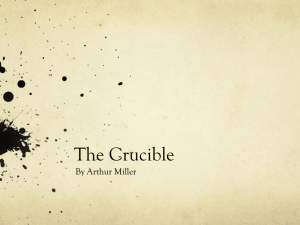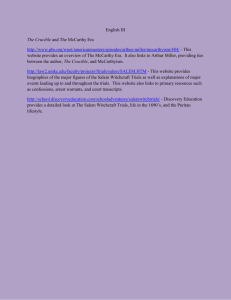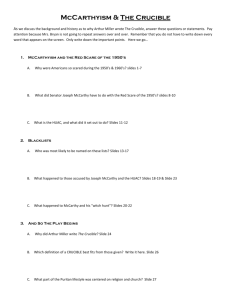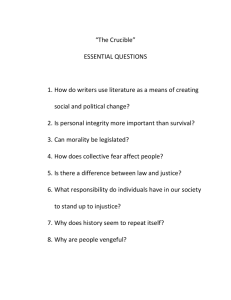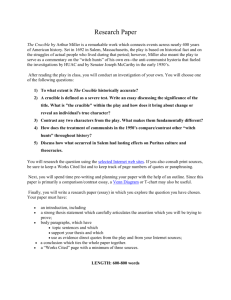File
advertisement
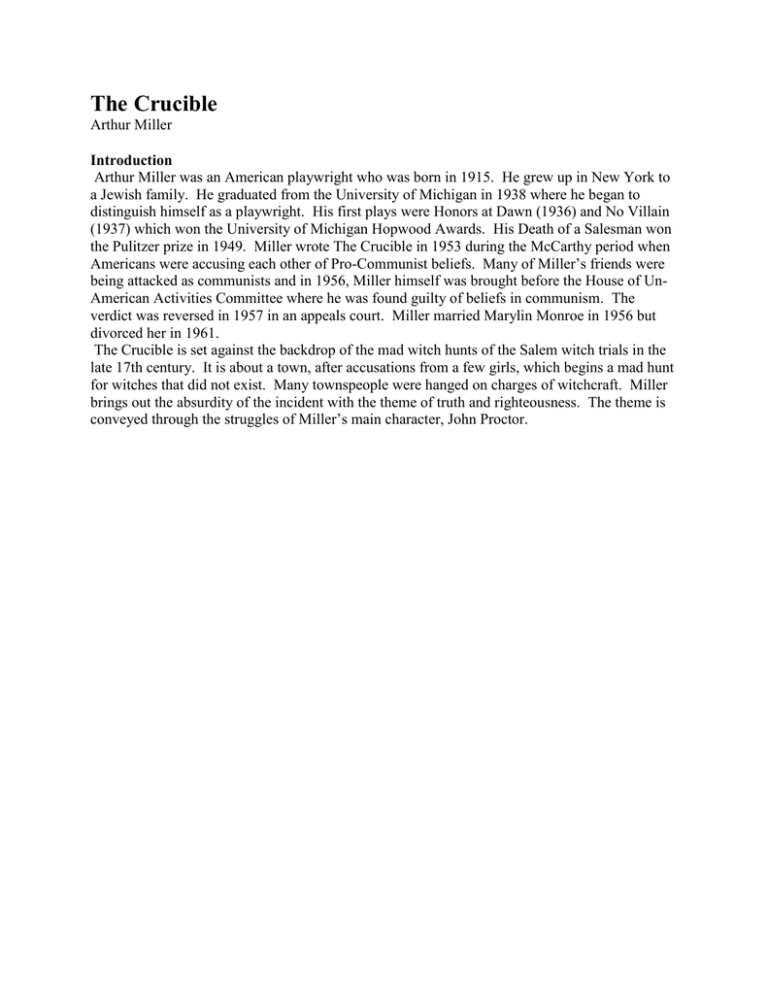
The Crucible Arthur Miller Introduction Arthur Miller was an American playwright who was born in 1915. He grew up in New York to a Jewish family. He graduated from the University of Michigan in 1938 where he began to distinguish himself as a playwright. His first plays were Honors at Dawn (1936) and No Villain (1937) which won the University of Michigan Hopwood Awards. His Death of a Salesman won the Pulitzer prize in 1949. Miller wrote The Crucible in 1953 during the McCarthy period when Americans were accusing each other of Pro-Communist beliefs. Many of Miller’s friends were being attacked as communists and in 1956, Miller himself was brought before the House of UnAmerican Activities Committee where he was found guilty of beliefs in communism. The verdict was reversed in 1957 in an appeals court. Miller married Marylin Monroe in 1956 but divorced her in 1961. The Crucible is set against the backdrop of the mad witch hunts of the Salem witch trials in the late 17th century. It is about a town, after accusations from a few girls, which begins a mad hunt for witches that did not exist. Many townspeople were hanged on charges of witchcraft. Miller brings out the absurdity of the incident with the theme of truth and righteousness. The theme is conveyed through the struggles of Miller’s main character, John Proctor. McCarthyism From Wikipedia, the free encyclopedia A 1947 comic book published by the Catechetical Guild Educational Society warning of the supposed dangers of a Communist takeover McCarthyism is the politically motivated practice of making accusations of disloyalty, subversion, or treason without proper regard for evidence. The term specifically describes activities associated with the period in the United States known as the Second Red Scare, lasting roughly from the late 1940s to the late 1950s and characterized by heightened fears of communist influence on American institutions and espionage by Soviet agents. Originally coined to criticize the anti-communist pursuits of U.S. Senator Joseph McCarthy, "McCarthyism" soon took on a broader meaning, describing the excesses of similar efforts. The term is also now used more generally to describe reckless, unsubstantiated accusations, as well as demagogic attacks on the character or patriotism of political adversaries. During the post–World War II era of McCarthyism, many thousands of Americans were accused of being Communists or communist sympathizers and became the subject of aggressive investigations and questioning before government or private-industry panels, committees and agencies. The primary targets of such suspicions were government employees, those in the entertainment industry, educators and union activists. Suspicions were often given credence despite inconclusive or questionable evidence, and the level of threat posed by a person's real or supposed leftist associations or beliefs was often greatly exaggerated. Many people suffered loss of employment, destruction of their careers, and even imprisonment. Most of these punishments came about through trial verdicts later overturned,[1] laws that would be declared unconstitutional,[2] dismissals for reasons later declared illegal[3] or actionable,[4] or extra-legal procedures that would come into general disrepute. The most famous examples of McCarthyism include the speeches, investigations, and hearings of Senator McCarthy himself; the Hollywood blacklist, associated with hearings conducted by the House Committee on Un-American Activities; and the various anti-communist activities of the Federal Bureau of Investigation (FBI) under Director J. Edgar Hoover. McCarthyism was a widespread social and cultural phenomenon that affected all levels of society and was the source of a great deal of debate and conflict in the United States. The Witchcraft Trials in Salem: A Commentary by Douglas Linder O Christian Martyr Who for Truth could die When all about thee Owned the hideous lie! The world, redeemed from superstition's sway, Is breathing freer for thy sake today. --Words written by John Greenleaf Whittier and inscribed on a monument marking the grave of Rebecca Nurse, one of the condemned "witches" of Salem. From June through September of 1692, nineteen men and women, all having been convicted of witchcraft, were carted to Gallows Hill, a barren slope near Salem Village, for hanging. Another man of over eighty years was pressed to death under heavy stones for refusing to submit to a trial on witchcraft charges. Hundreds of others faced accusations of witchcraft. Dozens languished in jail for months without trials. Then, almost as soon as it had begun, the hysteria that swept through Puritan Massachusetts ended. Only an unfortunate combination of an ongoing frontier war, economic conditions, congregational strife, teenage boredom, and personal jealousies can account for the spiraling accusations, trials, and executions that occurred in the spring and summer of 1692. A NOTE ON THE HISTORICAL ACCURACY OF THIS PLAY by Arthur Miller "This play is not history in the sense in which the word is used by the academic historian. Dramatic purposes have sometimes required many characters to be fused into one; the number of girls involved in the 'crying out' has been reduced; Abigail's age has been raised; while there were several judges of almost equal authority, I have symbolized them all in Hathorne and Danforth. However, I believe that the reader will discover here the essential nature of one of the strangest and most awful chapters in human history. The fate of each character is exactly that of his historical model, and there is no one in the drama who did not play a similar-and in some cases exactly the same-role in history. "As for the characters of the persons, little is known about most of them except what may be surmised from a few letters, the trial record, certain broadsides written at the time, and references to their conduct in sources of varying reliability. They may therefore be taken as creations of my own, drawn to the best of my ability in conformity with their known behavior, except as indicated in the commentary I have written for this text." The Meaning of the Crucible Title Major Theme A crucible is a vessel in which metal is heated to a high temperature and melted for the purposes of casting. It can also refer, metaphorically, to a time in history when great political, social, and cultural changes are in force, where society is seemingly being melted down and recast into a new mold. The word is also remarkably similar to crucifixion, which Miller certainly intended in choosing it as the title of his play. The picture of a man and a society bubbling in a crucible and the crucifixion of Christ interweave to form the main themes of the play: the problem of making the right moral choice and the necessity of sacrifice as a means of redemption. Both these themes, of course, take place in the context of the larger struggle of good versus evil. Minor Theme The Crucible's minor theme is the evils and events of the McCarthy era, which provided the initial inspiration for the play. Miller saw many parallels between the witch trials of Salem and McCarthy's hunt for Communists, which some critics at the time even referred to as a "witch hunt." Both were periods of dramatic social tensions and social change, marked by terror, suspicion, hysteria, and paranoia. While there were undoubtedly Communists in America in the 1950s, and perhaps witches in Salem in the late 1600s, the hunts for both destroyed many innocent lives and corrupted the accusers. Perhaps the most striking parallel between the McCarthy era and events in the play occurs in the scene where Parris accuses the signatories of Francis Nurse's petition of attacking the court and suggesting that no innocent person could possibly be unhappy with the court. This was the same logic that McCarthy and his followers used to discourage dissent. Although The Crucible can be read as a commentary on the McCarthy era, its location in actual historical events of another era, its emphasis on personal struggle and responsibility, and its aesthetic achievement as a work of literature and drama render it timely and relevant in any era. Indeed, as historical circumstances change, new historical parallels emerge. Miller has noted that when he wrote the play, he never could have imagined that people would see in it a commentary on the dangers of accepting children's testimony in sexual abuse cases, yet the parallel seems quite apparent now. It is The Crucible's timeless concern with the problems of ascertaining truth and obtaining justice, rather than its commentary on any one historic event, that has made it a lasting work of art.
